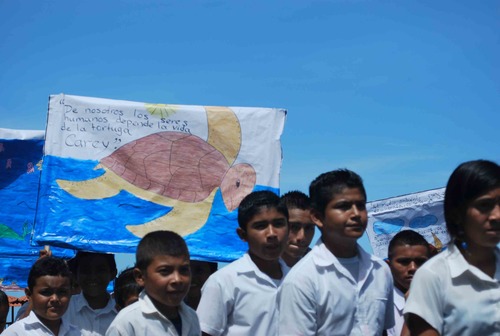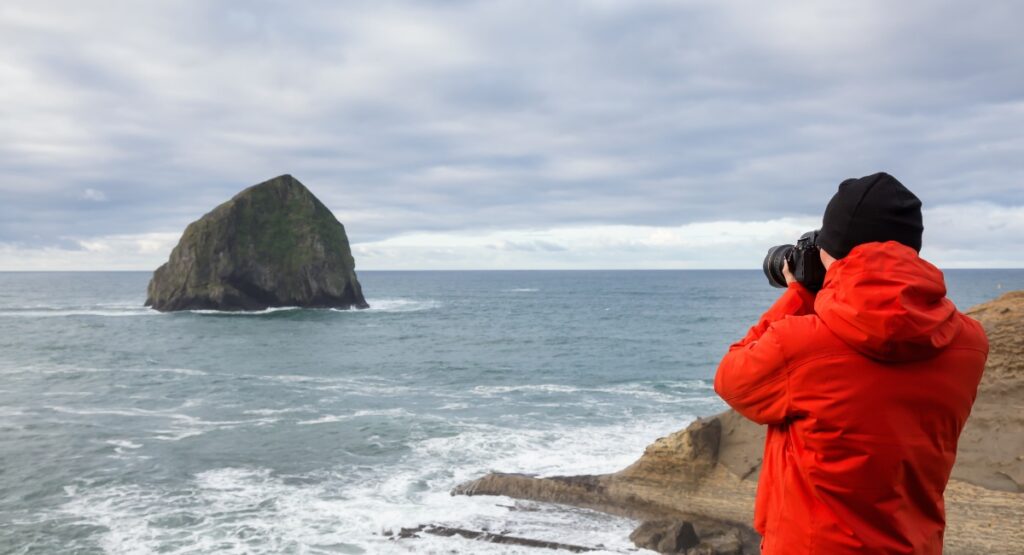Central America’s Forgotten Turtles
Getting to Know the Eastern Pacific Hawksbill, the World’s Most Endangered Population of Sea Turtles
By Brad Nahill, SEEtheWILD & SEE Turtles Co-Founder
“Time to get up, you’re going to miss the light!” The words pulled me out of a deep but brief sleep on the first day of my visit to Jiquilisco Bay, El Salvador. To call my condition at that moment disoriented would be an understatement. Luckily, I managed to gather my thoughts quickly enough not to fall out of my hammock onto the sand.
The wake-up call came from Alexander Gaos, executive director of the Eastern Pacific Hawksbill Initiative (known by its Spanish acronym, ICAPO) and a driving force behind one of the world’s most exciting sea turtle conservation programs.
We had spent most of the previous night looking for hawksbill turtles around the bay; an hour before daylight, we had arrived at the ICAPO hatchery, where I’d found an empty hammock and managed a short nap. The hatchery is a key tool that ICAPO uses to protect turtles, a safe place where the eggs can be watched under optimal conditions until they hatch.
I pulled out my camera and went to meet three female hawksbills that the local staff was holding in preparation for their role in a scientific research program. After a few minutes, we learned that hatchlings had recently emerged and were about to be released into the bay. Once I had reached the limits of my companions’ patience for taking photos of one sleepy hatchling, we hopped in a boat to head back to our base, the small island of La Pirraya.

It wasn’t long ago that many sea turtle experts assumed there were too few hawksbill turtles along the Pacific coast of the Americas to bother protecting. A report from the conservation group Oceana in 2007 stated matter-of-factly that “population levels are so low that scientists rarely encounter them.” One reason for this was the assumption that hawksbills in this region would live almost exclusively around coral reefs, as they do just about everywhere else in the world. This coast has relatively few reefs; therefore, scientists believed, there must be fewer turtles. In addition, no beaches along this coast had been identified as major hawksbill nesting sites, making it even more difficult to estimate population size.
Alexander and his wife Ingrid weren’t so sure the gloomy population estimates were correct. In 2008 they began researching hawksbills in Baja California, Mexico, and talking to other turtle conservationists in the region. Around that time, they met Michael Liles, a turtle researcher and now director of ICAPO-El Salvador, who had recently discovered the hawksbill nesting in Jiquilisco Bay during a nationwide beach survey. Determined to find additional nesting sites, the trio organized a meeting in El Salvador and invited turtle conservationists from around the region. One who attended was José Urteaga, Nicaragua Coordinator at Fauna & Flora International (FFI), who reported another potential nesting site in northwestern Nicaragua. These two nesting areas, less than 100 miles apart and unknown to science just a few years ago, now account for roughly 90 percent of known hawksbill nesting on the Pacific coast between Mexico and Ecuador.
The discovery of these two nesting areas has given new hope for the future of hawksbill turtles in the region. But it also creates a major sense of urgency to address the threats that the hawksbills face. One serious threat is from an especially destructive form of fishing used in the area, known as blast fishing. As violent as it sounds, this technique uses a mixture of sugar, chlorate, and sulfur to create an explosion that kills anything within an estimated radius of up to 80 feet (25 meters), including turtles. ICAPO estimates that more than 25 hawksbills have been killed by blast fishing in Jiquilisco Bay since 2004 (out of a total estimated regional population of fewer than 1,000 turtles). ICAPO has recently formed a partnership with US-based organization EcoViva to address blast fishing and lobby the government to enforce laws against this illegal fishing practice.
I had an opportunity to join an international research team visiting both of these Central American wildlife hotspots to learn about the threats to these turtles and the people working to protect them. Since we had arrived at Jiquilisco Bay in the dark, the morning boat ride was my first daylight impression of El Salvador’s largest wetland, critically important for its wildlife habitat and fisheries. The blue water was ringed by volcanoes, looming over the water like giant sentries. We arrived as preparations for the day’s big event, the annual Hawksbill Turtle Festival, were just getting underway.
The event started with a literal bang as a parade of hundreds of students from around the bay led by the Salvadoran Navy’s marching band and a school drum section made their way down the beach. The area’s major social event of the year, the festival included traditional dancing, speakers, a clown, and more. The first sight of turtles came at the end of the day as the adult hawksbills were brought over from the hatchery. Underneath a canopy that provided shade and space for the research team, the turtles waited patiently as satellite transmitters, the most high-tech gear in the turtle biologist’s toolbox, were applied to their shells. Key to the research that proved these hawksbills prefer mangrove habitats, these transmitters are are a valuable source of information for ICAPO and their partners.


This festival is one way ICAPO and their partners are working to educate local residents about the importance of protecting sea turtles. Following the event, we waited out a rainstorm and then headed back across the bay and from there by car back to San Salvador. After a brief nap at our hotel, we caught a two a.m. bus through Honduras to Nicaragua. An eight-hour bus ride later, we caught a taxi from the town of Chinandega to the small town of Padre Ramos, in the northwestern corner of Nicaragua.
The Padre Ramos Estuary is similar to Jiquilisco in shape, layout, and the presence of intact mangroves, although these forests cover a much smaller area here (28,000 hectares compared to 150,000 in Jiquilisco). Here, the main organization working with hawksbills is José Urteaga’s organization, Fauna & Flora International, in partnership with ICAPO and the Hawksbill Committee, made up of 18 local non-profit organizations, community groups, local governments, and others.
After settling into my cabin, I took a walk out to the ocean and then around the mouth of the estuary along the beach. The incongruous sound of mooing cattle echoed across the water. Tourism has barely touched Padre Ramos, as was evident from the curious looks the kids and even some adults cast my way. Though it was Nicaragua’s Revolution Day, most of the town was either watching a pick-up soccer game or swimming in the estuary.
In Padre Ramos, as in Jiquilisco Bay, conservation takes many forms. The primary way these turtles are protected is by enlisting the help of local residents (known as careyeros from the Spanish name for hawksbill, carey) to bring the eggs laid in nests dispersed around the estuary to the hatcheries. The careyeros know these hawksbills better than anyone, but before this project was founded in 2010, the eggs mostly ended up for sale on the black market. Both here and in El Salvador, the careyeros are paid by conservation groups for their work, earning income for the number of eggs they bring as well as how many hatch (to encourage careful handling of the eggs).

ICAPO and FFI have also launched an initiative to encourage competition between Padre Ramos and Jiquilisco Bay. The Copa Carey (Hawksbill Cup) uses the local love of soccer to encourage the participants to compete on a wide range of factors, including the number of nests, the number of hatchlings that survive, and local participation. With the program now in its second year, Michael Liles has seen a change in attitudes among some careyeros. He explains, “By adding non-economic incentives like the Copa Carey to egg protection, we can begin to change the view of sea turtles away from purely economic terms.”
As I flew home from Nicaragua, I reflected on how, in a few short years, this small group of scientists and local residents has managed to upend the scientific consensus regarding both where hawksbill turtles live and their status in this region. Groundbreaking scientific research, the protection of 90 percent of hawksbill eggs laid in both sites, and 200 local residents working to protect hawksbills on a budget equivalent to what some large nonprofits spend on membership mailings alone are just a few of the highlights.
At home that evening, getting ready to head to bed after an exhausting journey, I got online to catch up on Facebook. The first post I saw was from Michael Liles, reporting the death of four hawksbills in Jiquilisco, including one that we had just put a satellite transmitter on a few days before that died from blast fishing. While this was an avoidable tragedy, the efforts of local and international conservationists to bring this population back from brink of extinction give the Eastern Pacific hawksbill more than a fighting chance of recovery.
Learn More:
Links:



